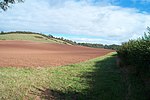Edington railway station

Edington Burtle railway station was a station on the Somerset and Dorset Joint Railway, and served the village of Edington, Somerset, UK. Originally named Edington Road, with the village two miles away, it became in 1890 the junction for the Bridgwater branch off the Highbridge line and for the next period in its life was known as Edington Junction. After the Bridgwater line closed to passengers in 1952, the station was renamed as Edington Burtle – Burtle is a village to the north of the station, and somewhat closer than Edington. In February 1956 the down platform and signal box was closed. Goods Yard closed on 13 July 1964. It closed in March 1966 when the line was shut as part of the Beeching axe.
Excerpt from the Wikipedia article Edington railway station (License: CC BY-SA 3.0, Authors, Images).Edington railway station
Edington Road,
Geographical coordinates (GPS) Address External links Nearby Places Show on map
Geographical coordinates (GPS)
| Latitude | Longitude |
|---|---|
| N 51.1811 ° | E -2.8716 ° |
Address
Edington Burtle
Edington Road
TA7 8NU , Burtle
England, United Kingdom
Open on Google Maps










